
Welcome to the 21st edition of First Nations News & Views. This weekly series is one element in the “Invisible Indians” project put together by Meteor Blades and me, with assistance from the Native American Netroots Group. Last week’s edition is here. In this edition you will find news about the Navajo Nation Annual Fair and crowning of Miss Navajo, an update on Pe’ Sla and Pat Rodgers’s last stand, a look at the years 1686 and 1935 in American Indian history, three news briefs and some bulleted news items. Click on any of the headlines below to take you directly to that section of News & Views or to any of our earlier editions.
By navajo
The 2012 Navajo Nation Fair is coming up on September 2. The eight-day event is the largest American Indian fair in the nation and is celebrating its 66th year. Navajo Code Talker Chester Nez, who is 90, will be the grand marshal. Nez is the only living member of the original 29 U.S. Marine Corps 382nd Platoon who used the Navajo language to develop an unbreakable secret code in World War II to defeat the Japanese.
The fair will be typical in many respects. There will be a parade, rodeo, half marathon race, concerts, dancing, horticulture and an art market. But the overall flare will be uniquely Navajo. Events such as a traditional Navajo song and dance competition will feature people, including many elders, from all over the reservation dressed in their finest traditional clothing. This is in addition to a general powwow competition that is open to all tribes.
The theme the year is Appreciating Tradition. In 1999, the Branch Chiefs of the Navajo government declared that one of the fundamental principles should be the preservation of Navajo culture.
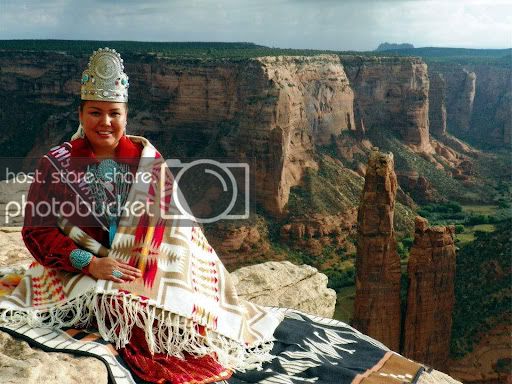
~Photo Courtesy of the Office of Miss Navajo Nation
Another event based on appreciating tradition is the Miss Navajo Nation contest. While most beauty pageants have been justifiably criticized for objectifying women and focusing entirely on their appearance to the exclusion of their achievements, this pageant has NEVER had a swimsuit competition, There is an evening gown competition but the contestants are advised to select outfits that are conservative and show respect to the elders in the audience. Modesty in dress is a strong norm on the reservation. There is also a traditional Navajo clothing contest in which the women display their rich velveteen ensembles with their family heirloom silver and turquoise jewelry. Traditional Navajo moccasins and leggings are usually worn.
There is a public speaking segment to the competition where the contestants must show their fluency in both English and Navajo. There is a public interview session where questions might include “According to Navajo mythology, how are the stars created and placed?” and “How does the Navajo seal reflect the Navajo government?”
Each contestant must perform a skill and a talent in both the categories of traditional and modern. The modern category must be done in English and the traditional one in Navajo. Modern skills could include dance, acting, gymnastics. Modern talents can include singing, literary arts or musical performance. Traditional skills can be dancing, weaving, storytelling, making jewelry and grinding corn. Acceptable traditional talents include singing, musical performance or hobbies presented in an artful or musical format in Navajo.
Of course there is a fry bread contest, which is probably a popular expectation of a Miss Navajo Nation contestant. But many people do not know that there is a sheep-butchering competition. This event draws the largest crowds of spectators aside from the coronation. Sheep are held in very high regard on the reservation. They sustain life. Traditional Navajo families still maintain herds of sheep, and they must butcher them themselves. I’ve watched my aunties do this many times. It’s a definitive part of our culture and one that the Miss Navajo Council thought should be one of the selection methods for the crown. Sheep butchering became required in 1995 as a competition category.
Contestants are formed into small teams. They all begin at the same time and the team furthest along in the process after one hour wins points for each of the contestants. Each team must carry a live sheep to the arena, slit its throat, drain the blood into pans, break off its hooves, sever the head, hoist the carcass to hang and finish butchering, skin the fleece, remove and save all the organs, which will be cleaned and prepared for grilling. Cheered by the crowd are hallmarks such as hoisting the sheep to a hanging position or properly removing the legs but keeping them connected by the back muscles so they can be hung to cure, an important Navajo treatment.
According to the Miss Navajo Nation Council, “the pageant winner represents womanhood and fulfills the role of “grandmother, mother, aunt and sister” to the Navajo people. As a role model, Miss Navajo must exemplify the essence and characters of First Woman, White Shell Woman and Changing Woman and to display leadership as the Goodwill Ambassador.”
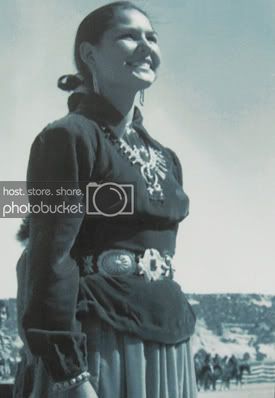
Dr. Beulah Ream Allen in 1952
Sixty years ago, at its annual fair, the Navajo Nation selected its first Miss Navajo Nation, Beulah Ream Allen. She was 55 when she was crowned. In those days, the “contestant who received the most and loudest applause from the audience would be crowned as the new Miss Navajo.” No surprise that Dr. Allen won. A physician, she had delivered many Navajo babies and taken care of the sick at Chinle. Today, a panel of judges assign points to each contestant for each of the contest categories over a five-day period.
In 1956 through 1963 there were two appointed Miss Navajos, one traditional and one modern. “Both positions were prestigious, as it was the responsibility of each to bridge the gap between the outside world and the Navajo Nation.” Sunni Dooley, Miss Navajo 1982-83, quipped that the modern one was always “one who looked like Jackie Kennedy.” Many photos of the past Miss Navajos can be seen here.
Currently, Miss Navajo’s duties are to promote and educate about the Navajo culture, language and traditions. She travels internationally and locally on behalf of the Navajo people for one year.
Unlike most beauty pageants around the world, the Miss Navajo Nation competition is about the Navajo word for beauty, balance and harmony: hózhǫ́ in short. The Navajo mantra is to do everything with beauty. Walk in beauty, think in beauty. If you perform your life’s actions in a beautiful way, then harmony with the earth will be balanced and achieved. Miss Navajo Nation is about the beauty within.
A film documentary by Billy Luther (Navajo, Hopi and Laguna Pueblo), Miss Navajo, was released in 2006.

By Meteor Blades
On Aug. 27, 1686, the Lenni Lenape (Delaware) chiefs Mayhkeerickkishsho, Sayhoppy and Taughhoughsey supposedly sold lands along the Delaware River on the border between present-day Pennsylvania and New Jersey to William Penn. The land in question was to be measured by how far a man could walk in a day and half. Thus was born the notorious “Walking Purchase”-if one believes the document was real. No original was ever found and there is no record of the sale in Pennsylvania’s provincial land records.
Such paced-off land deals were not an unusual practice in those days. Even though King Charles II had granted all of Pennsylvania to Penn in 1681 with a stroke of his royal quill, Penn himself cultivated peaceful relations with the Indians in the region by treating them, by the standards of the time, with fairness and an honest tongue. Among other things, before selling land to colonists, Penn bought it from the Indians living on it, set clear boundaries and made sure payment was actually given. There were many such purchases, most of them small.
After Penn’s death in 1718, his sons gained the proprietorship of Pennsylvania. They had a taste for the good life and consistently outspent their income, incurring huge debts. But there was a remedy close at hand. European settlers were pouring into the area, many of them merely squatting on Native land without permission. The Proprietors felt an urgent need to extend their authority into those lands, particularly into areas where German immigrants had settled across the line from New York.
It was at this time-1732 or 1734, historians differ-that a copy of the 1686 treaty, which somehow hadn’t previously come to light, was conveniently discovered by Thomas Penn. Indians had not heard of this treaty and were, to put it mildly, not interested in ceding land that they did not believe they had ever agreed to transfer nor for which they had ever been paid. The 1686 document was incomplete and unsigned and perhaps wholly fabricated. In other words, it was a swindle. Nonetheless, the Penns began selling Lenape lands in the area before the Indians agreed and before any effort was made to measure its area.
The Lenape went to the Iroquois Confederacy seeking redress. But the Iroquois, to whom the Lenape were subordinate, had no interest in helping and themselves made a deal with the Penns giving up their interest in the land at question. Eventually, in 1737, helpless to resist effectively, enough Lenape grudgingly agreed to the deal. And so the measurement was made. The Indians figured, based on previous walking purchases, that the walkers could cover perhaps 35-40 miles. But the Penns were not their father. They hired the three fastest men they knew, cleared the route ahead of time and sent them on their way along a northwesterly route not set out by the alleged 1686 document. So fast did they go that two of the men dropped out and the third collapsed from exhaustion, having covered about 70 miles, reaching near the present-day Jim Thorpe, Pa., at the foot of the Blue Mountain.
The Lenape chief Lappawinsoe said of the cheating:
[the white runners] should have walkt along by the River Delaware or the next Indian path to it… should have walkt for a few Miles and then have sat down and smoakt a Pipe, and now and then have shot a Squirrel, and not have kept up the Run, Run all day.
When the surveyor’s lines were drawn, the “Walking Purchase” encompassed 1.2 million acres.
The Lenape refused to surrender the land and the Proprietors sought help from the Iroquois in pushing them out, which those Indians did. In 1741, having no choice but a war they could not win, the Lenape left, beginning a journey with a series of stopovers that eventually took them, under constant duress, to Indian territory, today’s Oklahoma. Today, there are two federally recognized tribes there, although Lenape also live in small clusters in New Jersey and Wisconsin.
In 2004, the Lenape sued in federal court to regain 315 acres of the original Walking Purchase. In Delaware Nation v. Pennsylvania, the U.S. Third Circuit Court of Appeals ruled against the tribe. While there was included in the ruling a sentence about the “sad example of our forefathers’ interactions with the Indian nations,” the justices said it made no difference whether the land had been purchased or taken by fraud since Thomas Penn had sovereignty under the “doctrine of discovery.” The court thus had no jurisdiction in the matter of the extinguishment of aboriginal title. The U.S. Supreme Court chose not to take up the case on appeal.

On Aug. 28, 1935, Congress passed the Indian Arts and Crafts Act. The purpose behind this was to “promote the economic welfare of the Indian tribes and Indian individuals through the development of Indian arts and crafts and the expansion of the market for the products of Indian art and craftsmanship.” That act, and the subsequent Indian Arts and Crafts Act of 1990 created a board within the Department of Interior whose tasks included creating “Government trade marks of genuineness and quality for Indian products and the products of particular Indian tribes or groups; to establish standards and regulations for the use of such trade marks; to license corporations, associations, or individuals to use them; and to charge a fee for their use; to register them in the United States Patent Office without charge.”
Under the 1990 act, truth-in-marketing regarding the Indian heritage and tribal affiliation of those who make crafts sold as Native products is required. A 2010 amendment allows for fines for violations by individuals of up to $250,000 and 15 years in the slam. Businesses can be fined up to $5 million and incur civil penalties as well.

Sources:
• The Walking Purchase, Pennsylvania Historical & Museum Commission.
• The Walking Purchase August 25, 1737, Pennsylvania Historical & Museum Commission.
• Delaware Nation v. Pennsylvania
• The Delaware Indians: A History, by C.A. Weslager
• Indians 201: The Doctrine of Discovery, by Ojibwa
• The Indian Arts and Crafts Act of 1935, UA Native Net

Pueblo Indian Council Calls for Removal of Custer-Loving New Mexico GOP Official
Sometimes, given the outlandishness of what’s said, you have to wonder if Republicans aren’t reading from a script slipped under the door to them by Democrats. That’s what it seems like in the case of Pat Rogers’s remarks about Lt. Col. George A. Custer contained in an email to New Mexico’s Republican governor, Susana Martinez. The email has spurred the All-Pueblo Council to demand the removal of Rogers from his post as Republican National Committeeman.
Rogers is a heavy hitter in GOP circles in New Mexico, a partner and vice-president of the Modrall law firm of Albuquerque. He’s a registered lobbyist for Verizon, General Motors, Scientific Gaming and the University of Phoenix, among others. He was in 2007 the favored choice of a Karl Rove flunky for replacing David Iglesias, the U.S. Attorney fired because the Bush administration didn’t think he was tough enough on voter fraud. Rogers had once called voter fraud “the single greatest wedge issue ever” and was instrumental in getting Yglesias tossed. So he was on the short list for the U.S. attorney job. He has also been implicated in the “emailgate” scandal in which private emails regarding public business have raised the possibility of bid-rigging and collusion.
Earlier this month, ProgressNow, a progressive grassroots organization, reported that Rogers had sent a June 8 email to Martinez after she had met with tribal leaders in the state:
Quislings, French surrender monkeys, secret supporters (all along) of JAJ [Janice Arnold Jones]
The state is going to hell. Col. [Allen] Weh [Martinez’s 2010 GOP primary opponent] would not have dishonored Col Custer in this manner.
I hope who ever recommended this is required to read the entire redist [redistricting law suit] transcript and sit through the entire meeting with the Gov.
The email, which you can read in its entirety here, didn’t become widely known until Ryan J. Reilly brought it up at Talking Points Memo Friday. The same day, Rogers offered a lame apology, justifying his comment calling Martinez a traitor in various ways as being humorous. The chairman of the Republican Party of New Mexico has accepted the apology.
Some other folks did not.
On Saturday the chairman of New Mexico’s All Indian Pueblo Council called the email “racist in tone” and said Rogers should be removed as Republican National Committeeman. Chairman Chandler Sanchez said:
I call upon the Republican National Committee to remove Mr. Rogers from his official capacity within the committee. … His statement that Custer is some kind of hero demanding deference is offensive. We have come a long way in demanding racial tolerance and acceptance in the 21st century. But remarks and statements like those written by attorney Pat Rogers sadly make you wonder if the Republican Party and those who represent Governor Martinez share his views and attitude toward the Native populations of this state.”
It’s hard to imagine how any more dishonor could be brought against Custer than what he brought upon himself. In addition to the reckless pride that wiped out his command on the Little BigHorn in 1876, there was the massacre on the Washita River in 1868 and Custer’s custom of choosing an Indian woman to sleep with when he was in the field. Commonly known as rape.
One of these was a Cheyenne woman captured on the Washita, Monahseetah, with whom Custer supposedly fathered a blond child, Yellow Bird. But some historians believe the gonorrhea Custer had contracted at West Point made him sterile and the actual father of the Indian boy was Custer’s brother, Thomas. Share and share alike, it seems. Whatever the case, when Custer’s wife Libby came out West to be with him, he abandoned Monahseetah. No Cheyenne would marry her.
It’s unknown whether Libby ever learned of her husband’s activities in this regard. If so, it did not stop her from spending decades transforming him after his death into a glorious hero. So much so that President Theodore Roosevelt warned Edward Curtis in 1907 that the famed photographer should not include a story in his forthcoming book on The North American Indian that put a harsh light on Custer’s behavior in the battle. The nation, Roosevelt told him, was not ready just three decades after the Battle of the Little BigHorn to see Custer demoted from the pantheon of “legitimate” heroes. Curtis agreed and left out what he had learned from men who had witnessed the battle.
Previously, only one man’s views had been accepted, a Crow scout named Curley who had bolstered the view that Custer had behaved as a good leader once the fight got under way. Curley was long said to have been the only survivor among the four scouts who were with Custer that June Day in Montana. But there were three others who told Curtis their story:
The three scouts’ narrative differed sharply from the accepted story, most markedly in their assertion that Custer had paused for 45 minutes on a high point on the bluffs, where he watched [Major] Reno’s defeat and declined to go to the major’s aid. […]
To the Scout’s thinking Custer should ride down there immediately and support Reno. “White Man Runs Him” became agitated and went up to Custer and told him that this is what Custer should do. “White Man Runs Him” relayed the exchange between him and Custer this way:
[White Man Runs Him] “I said, ‘Why don’t you cross the river and fight too?’ I scolded him. Custer replied ‘It is early yet and plenty of time. Let them fight. Our turn will come.’”
And so it did. While scholars knew better, not until the 1960s did the public get an inkling of Custer’s true self. The earlier heroic version was promoted by a score of bad films and his toppling from the pedestal in the public’s mind was also a product of a film, the 1970 Little Big Man, in which he is devastatingly depicted.
Rogers, who backed Weh in the 2010 primary, has many problems with the governor. But it’s difficult to understand why he picked Custer as his choice for taking his gratuitous poke at her for showing up at a meeting she is, by state law, required to attend. Custer never had anything to do with Indians in New Mexico.
So maybe it was just a casual slur. But it’s not hard to imagine Rogers being one of the Custer-loving morons who chose to send anonymous racist hate mail to the National Park Service in the year or so before it renamed the Custer Battlefield the Little Bighorn National Battlefield Monument in 1991. To some people, the man is still a hero.
•••
Land of Enchantment will be diarying in detail Monday on some of Rogers’s activities.

Auction Canceled But the Selling of Pe’ Sla Continues
While the public auction of land sacred to the Sioux in the Black Hills of South Dakota has been canceled, a quiet sale of the land is going on privately.
We reported in FNN&V last week that Pe’ Sla, a site sacred to the various Sioux tribes, was to be auctioned Saturday. To guarantee access, the Rosebud Sioux Tribe (Sicangu Oyate Lakota) initiated a campaign to raise money to buy as many of the five tracts of the 1942-acre total as possible. At a potential high bid around $5000 an acre, everybody knew it would be an uphill battle, $10 million is no small matter regardless of who is raising the money and the Sioux are among the most impoverished citizens in our nation.
The outpouring of support was tremendous. As of today, $288,000 has been raised. The Rosebud Sioux have pledged another $1.3 million and some the other Sioux tribes plan to provide money of their own in this effort.
However, the fund-raising campaign turned into a double-edged sword. The publicity apparently spurred the property-owners to cancel the auction, and take the sale behind closed doors. Brock Auction Co., which was handling the sale of the land-divided into five tracts-made the announcement Thursday. The family gave no explanation.
Ruth Moon reported:
Neither the family nor the auction company has given a reason for the change, but one can offer a guess. Perhaps it was the thousands of tweets, the scores of news stories, and the hundreds of thousands of dollars raised in an unprecedented fund-raising campaign to buy the land back for the tribes by LastRealIndians.com. Or the threat of sale day becoming a major media draw, complete with prayer circles and protesters both near and far.
But the final straw may have been yesterday’s announcement by the United Nations Special Rapporteur on the Rights of Indigenous Peoples, strongly suggesting consultation with tribes on the impending sale.
As we reported in May, the Special Rapporteur, James Anaya, said that one of the things the United States could do to improve relations with the nation’s tribes would be to return some lands to the tribes, including the Black Hills, which were taken in a congressionally mandated land grab in 1877.
The Rapid City Journal reported on the cancelation of the aucton:
“We’re on pins and needles,” said Chase Iron Eyes, owner of Last Real Indians, a website and organization raising money to buy the land. “We’re nervous. We don’t know if it’s good or bad or what it is.”
“It could be good and it could be bad,” said Rodney Bordeaux, president of the Rosebud Sioux Tribe. “We just don’t know what the family wants. That’s kind of the unknown. We’ll just have to wait and see.”
Here’s Iron Eyes (Standing Rock Sioux) thanking donors and explaining the latest developments as they were known as of Saturday.
A staff member of the Lakota Peoples Law Project told FNN&V that the organization had phoned the real estate company now in charge of the Pe’ Sla sale to scope out the situation and was asked if he wanted to make a bid for the property. There are unconfirmed rumors that the sale will be completed Monday.
Even with so many unknown factors, the Native grass roots organizers are hopeful. With their efforts to gather financial support from several Sioux tribes and the public’s help this huge purchase is possible.
The fund-raising continues.
At the Standing Rock Sioux Reservation, which straddles North and South Dakota, $300.03 was raised with a blanket dance during the traditional Wakpala Wacipi (powwow) last week. “The elders in the community, the Uncis and Lalas (Grandmas and Grandpas) were brought to tears to see their children and grandchildren working to get our sacred lands back,” Iron Eyes said.
You can contribute here.

Street Art Hits the Red Road: Lakota Activist Madonna Thunder Hawk Protests Pe’ Sla Sale to Non Natives
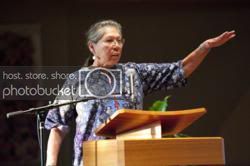
Next weekend Madonna Thunder Hawk of the Lakota People’s Law Project will travel throughout South Dakota in a truck draped with two 28-by-10-foot banners by street artist Shepard Fairey, National Geographic photographer Aaron Huey, and graphic artist Ernesto Yerena. The art will feature the words “The Black Hills Are Not For Sale” and “Honor The Treaties.” The first stop will be the big powwow on Cheyenne River and then follow up with a Pe’ Sla action in Rapid City next week. As we have reported last week and this, Pe’ Sla is sacred to the Sioux people.
Last November, Fairey and Huey wheat-pasted a 20-by-60-foot mural on the Barracuda wall on Melrose Ave. in Los Angeles. The mural featured a photograph, taken by Huey and adapted by Fairey, of a young Lakota girl with a feather in her hair. Its caption read “The Black Hills Are Not For Sale.” The words refer to the U.S.’s current policy of violating the 1868 Treaty of Fort Laramie and the Lakota’s refusal to accept compensation for the Black Hills.
The art displayed in Los Angeles last fall will be featured as an act of protest by Madonna Thunder Hawk in South Dakota next weekend on one side of an enormous truck. Another banner by Yerena and Huey will appear on the other side of the truck, with the caption “Honor The Treaties.”
Thunder Hawk has worked for five years with the Lakota People’s Law Project (LPLP) of Rapid City and Santa Cruz, California. Her work consists of organizing Lakota, Dakota, and Nakota grandmothers in South Dakota to win the return of Native American children to their families and tribes from white-run foster care, as mandated by the 1978 Indian Child Welfare Act. Thunder Hawk and the Lakota People’s Law Project are fully supportive of all groups working to prevent Pe’ Sla from being sold to non-Native buyers.

•
-Meteor Blades
-navajo
Indians have often been referred to as the “Vanishing Americans.” But we are still here, entangled each in his or her unique way with modern America, blended into the dominant culture or not, full-blood or not, on the reservation or not, and living lives much like the lives of other Americans, but with differences related to our history on this continent, our diverse cultures and religions, and our special legal status. To most other Americans, we are invisible, or only perceived in the most stereotyped fashion.First Nations News & Views is designed to provide a window into our world, each Sunday reporting on a small number of stories, both the good and the not-so-good, and providing a reminder of where we came from, what we are doing now and what matters to us. We wish to make it clear that neither navajo nor I make any claim whatsoever to speak for anyone other than ourselves, as individuals, not for the Navajo people or the Seminole people, the tribes in which we are enrolled as members, nor, of course, the people of any other tribes.
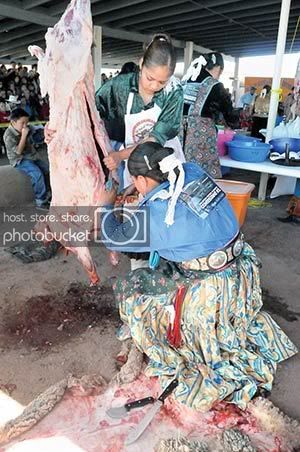
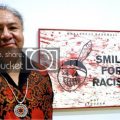
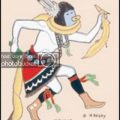


Leave a Reply